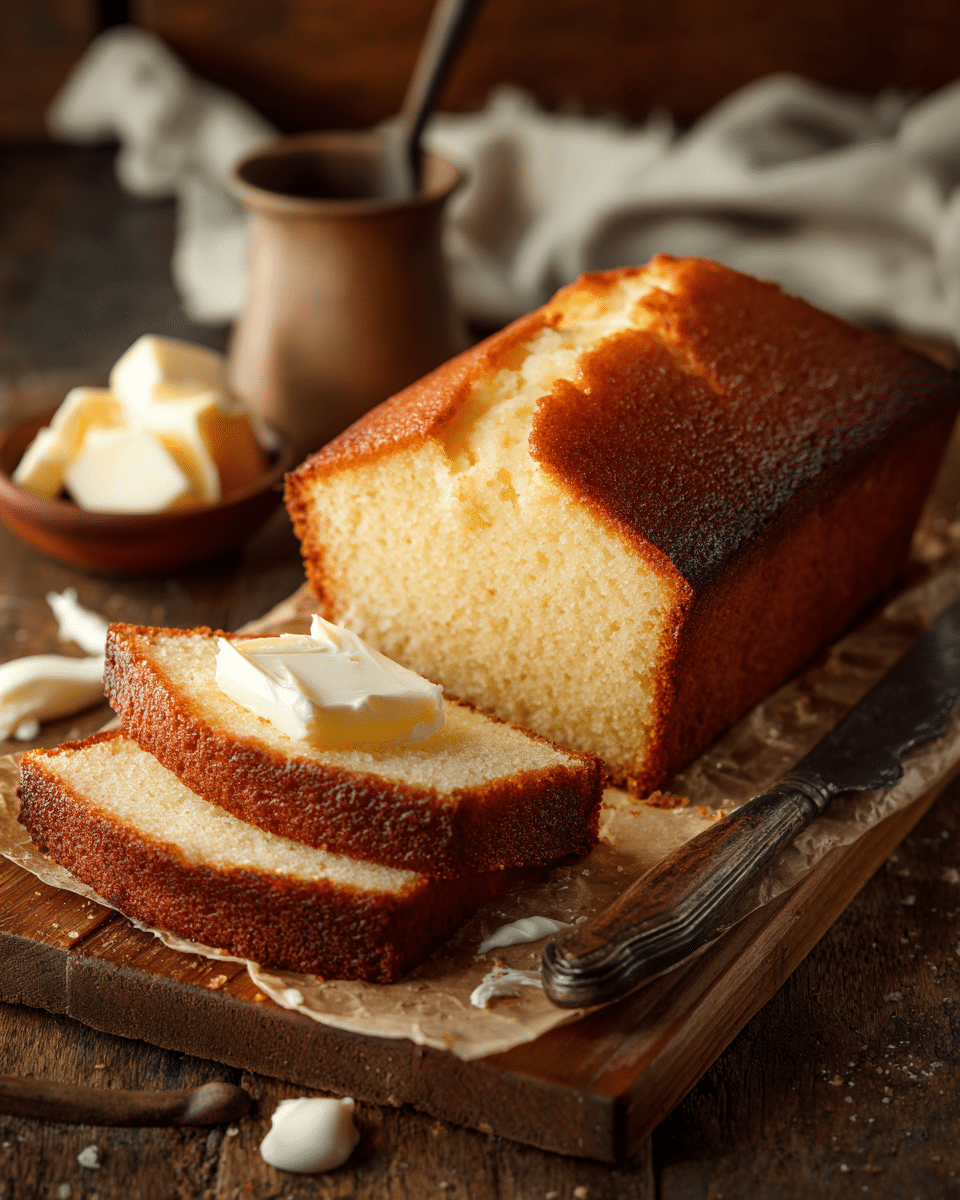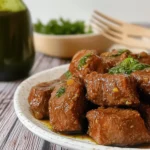This Buttery Vanilla Pound Cake is a beloved classic passed down from Grandma’s kitchen. Its name comes from the traditional recipe using a pound each of butter, sugar, eggs, and flour. While modern adaptations scale it down, the rich flavor and dense, moist crumb remain unchanged. With a delicate vanilla aroma and golden crust, this pound cake is perfect for celebrations, tea time, or simply enjoying a nostalgic slice with coffee. It’s a timeless recipe that brings warmth and comfort in every bite.
FULL RECIPE
Ingredients
- 1 cup (2 sticks) unsalted butter, softened
- 1 1/2 cups granulated sugar
- 4 large eggs, room temperature
- 2 teaspoons pure vanilla extract
- 2 cups all-purpose flour
- 1/2 teaspoon baking powder
- 1/4 teaspoon salt
- 1/2 cup whole milk, room temperature
Directions
- Preheat oven to 325°F (163°C). Grease and flour a 9×5-inch loaf pan or line with parchment paper.
- In a large mixing bowl, cream the butter and sugar together using a hand or stand mixer on medium speed until light and fluffy (about 3–5 minutes).
- Add eggs one at a time, beating well after each addition. Mix in the vanilla extract.
- In a separate bowl, whisk together the flour, baking powder, and salt.
- Gradually add the dry ingredients to the wet mixture, alternating with the milk, beginning and ending with the flour mixture. Mix until just combined—do not overmix.
- Pour the batter into the prepared pan and smooth the top with a spatula.
- Bake for 60–70 minutes, or until a toothpick inserted into the center comes out clean.
- Let the cake cool in the pan for 10–15 minutes, then transfer to a wire rack to cool completely.
- Slice and serve as is, or top with whipped cream, berries, or a dusting of powdered sugar.
Nutrition Facts
- Calories: 330
- Total Fat: 18g
- Saturated Fat: 11g
- Cholesterol: 95mg
- Sodium: 120mg
- Total Carbohydrates: 38g
- Dietary Fiber: 0.5g
- Sugars: 24g
- Protein: 4g
- Vitamin A: 10% DV
- Calcium: 4% DV
- Iron: 6% DV
Flavor and Texture Profile
This pound cake is known for its buttery richness, subtle vanilla aroma, and finely textured crumb. It strikes a balance between density and tenderness, with a golden-brown crust that gives way to a moist, buttery interior. The cake isn’t overly sweet, which allows the pure vanilla flavor to shine. Every bite feels indulgent, yet familiar and comforting. When made properly, the texture is smooth and tight, holding together beautifully when sliced, making it ideal for plating, gifting, or serving at gatherings.
Healthier Ingredient Swaps
Although pound cake is traditionally indulgent, it can be modified to suit specific dietary preferences. For a lighter version, you can reduce the sugar slightly or use a sugar substitute like stevia or monk fruit sweetener. Swapping half of the all-purpose flour with whole wheat pastry flour adds fiber without altering texture too drastically. For those watching cholesterol, replacing half the butter with Greek yogurt or unsweetened applesauce can help reduce saturated fat. Using plant-based milk and butter alternatives makes the recipe suitable for lactose-intolerant or dairy-free diets while still preserving a soft crumb.
Creative Variations
The versatility of this pound cake makes it a perfect base for creative tweaks. You can fold in lemon or orange zest for a citrusy twist or add almond extract for a nutty depth of flavor. Swapping vanilla for rum or bourbon gives the cake a more adult flair. For texture, consider mixing in chopped nuts, dried cranberries, or mini chocolate chips. A marble pound cake can be created by swirling in melted chocolate or cocoa powder into half of the batter before baking. These variations allow the classic recipe to evolve while preserving its essential charm.
Glazing and Topping Options
While delicious on its own, a good topping can elevate this pound cake to a bakery-level treat. A simple vanilla glaze made from powdered sugar and milk adds sweetness and sheen, while a drizzle of lemon glaze brings a refreshing contrast. For a richer option, top it with a chocolate ganache or caramel sauce. Whipped cream, fresh berries, or sliced stone fruits offer a fresh, colorful touch that’s ideal for serving at brunches or summer gatherings. Powdered sugar dusted over the top is a timeless, elegant finish for a more traditional presentation.
Perfect Pairings
Buttery Vanilla Pound Cake pairs beautifully with a wide range of beverages and accompaniments. It complements a cup of black coffee or English breakfast tea, making it a great afternoon snack. For dessert, pair it with a scoop of vanilla bean ice cream or a side of macerated strawberries and whipped cream. During colder months, a warm slice served with mulled cider or hot chocolate makes for a comforting treat. The cake also works wonderfully as the base for layered trifles or parfaits, absorbing flavors without becoming soggy.
Serving Ideas for Different Occasions
This cake is incredibly adaptable to different occasions and serving styles. For casual family meals, a simple sliced presentation is perfect. For more formal events, serve slices plated with fresh fruit, edible flowers, or artistic drizzles of sauce. Mini loaf versions or pound cake cupcakes make excellent additions to tea parties or bake sales. It’s also a thoughtful gift, especially when baked in decorative pans or wrapped in parchment and tied with ribbon. Whether for holidays, birthdays, or just because, this pound cake always feels appropriate and appreciated.
Storage and Shelf Life
Proper storage is key to maintaining the moist texture of this pound cake. At room temperature, it can last for up to 4 days when tightly wrapped in plastic wrap or stored in an airtight container. Refrigeration extends its shelf life to about a week, but always allow it to return to room temperature before serving for the best texture. This cake also freezes exceptionally well—wrap it in plastic and then foil, and it can be stored in the freezer for up to three months. Simply thaw overnight in the fridge or on the counter before enjoying.
Tips for a Perfect Bake
To get the best results, ensure all ingredients are at room temperature before mixing. Creaming the butter and sugar thoroughly is crucial for incorporating air, which helps create the cake’s signature dense-yet-tender crumb. Be careful not to overmix once the flour is added, as this can lead to a tough texture. Greasing and flouring the pan ensures easy release and a smooth crust. Bake the cake on the center rack and avoid opening the oven early, as this can cause it to sink. Always test with a toothpick—clean removal signals it’s ready.
Pound Cake in Culinary Culture
The pound cake has long held a special place in Western culinary history. Originating in Europe in the 18th century, it was traditionally made with a pound each of flour, butter, sugar, and eggs—hence the name. Over time, it spread to American kitchens, where it became a Southern staple and an essential part of holiday and potluck tables. Its simplicity allowed it to be customized regionally, with additions like sour cream, spices, or fruit. Today, the pound cake is a symbol of comfort and hospitality, celebrated for both its enduring form and its versatility.
Advertisement
Conclusion
The Buttery Vanilla Pound Cake stands as a testament to the power of simplicity in baking. Rich, moist, and aromatic, it continues to bring joy to countless households, whether as a sweet treat with afternoon tea or the centerpiece of a festive dessert table. Its nostalgic value, adaptability, and reliability make it a treasured recipe that transcends generations. Whether you stick to the classic formula or make it your own with modern twists, this pound cake offers warmth, flavor, and tradition in every slice—a true timeless favorite that never goes out of style.






